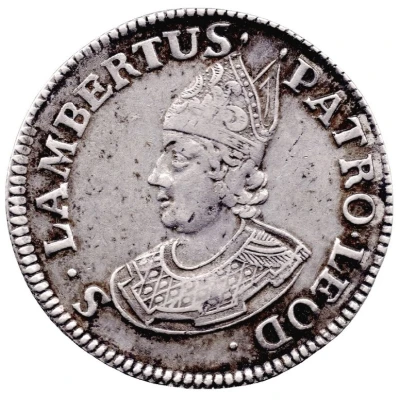


© Vitis
Escalin - Jean-Théodore of Bavaria
| Silver (.569) | 4 g | 24 mm |
| Issuer | Prince-bishopric of Liege (Belgian States) |
|---|---|
| Prince-bishop | John Theodore of Bavaria (1744-1763) |
| Type | Standard circulation coin |
| Years | 1752-1753 |
| Value | 1 Escalin (½) |
| Currency | Florin Brabant-Liege (1650-1795) |
| Composition | Silver (.569) |
| Weight | 4 g |
| Diameter | 24 mm |
| Thickness | 1.15 mm |
| Shape | Round |
| Orientation | Coin alignment ↑↓ |
| Demonetized | Yes |
| Updated | 2024-10-04 |
| Numista | N#48006 |
|---|---|
| Rarity index | 67% |
Reverse
Rampant lion left
with sword and coat of arms of Bouillon
Script: Latin
Lettering: EP·ET·PR·LEO·DVX·B·M·F·C·L·H
Translation:
EPISCOPUS ET PRINCEPS LEODIENSIS DUX BULLONIENSIS MARCHIONIS FRANCHIMONTIS COMES LOSENSIS HORNENSIS
Prince-bishop of Liege, duke of Bouillon, marquis of Franchimont, count of Loon and Horne
Edge
Corded (small squares in hollow)
Comment
https://en.wikipedia.org/wiki/Johann_Theodor_of_BavariaInteresting fact
One interesting fact about the Standard circulation coin Escalin - Jean-Théodore of Bavaria 1752-1753 from Prince-bishopric of Liege (Belgian States) made of Silver (.569) weighing 4 g is that it was minted during a time of great political and economic change in Europe. The coin was issued during the reign of Prince-Bishop Jean-Théodore of Bavaria, who was a member of the powerful Wittelsbach family that ruled over a large portion of Europe. The coin's minting was likely a response to the growing need for currency in the region, as trade and commerce were expanding rapidly during this time. Despite its age, the coin remains a valuable piece of history and a testament to the economic and political developments of the time.



